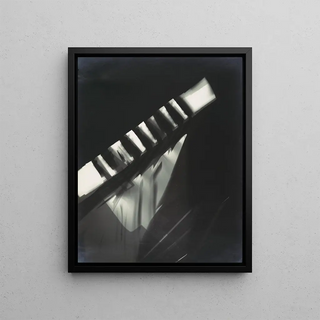Art print | Photogram - László Moholy-Nagy


View from behind

Frame (optional)
Photogram Art print - László Moholy-Nagy – Captivating Introduction
In the fascinating universe of modern art, the photogram by László Moholy-Nagy stands out for its boldness and its ability to transcend traditional boundaries of photography. This iconic piece, created in the 1920s, embodies the innovative spirit of the Bauhaus, a movement of which the artist was one of the leading representatives. Playing with light and shadow, Moholy-Nagy captured abstract forms that evoke a poetic and mysterious dimension. The photogram art print - László Moholy-Nagy allows for an appreciation of this visual exploration, offering a glimpse into how art can dialogue with technology and everyday life.
Style and uniqueness of the work
Moholy-Nagy's style is characterized by an experimental and avant-garde approach. In the photogram, he features everyday objects, playing with light to create dynamic compositions. The absence of a camera in this technique enhances the unique character of the piece, each print resulting from direct manipulation of light on photographic paper. The forms overlap, cross, and intertwine, giving the whole a striking depth and visual richness. This interplay between abstraction and representation makes the photogram an artwork that is both accessible and complex, inviting the viewer to reflect on the very nature of the image.
The artist and his influence
László Moholy-Nagy, born in 1895 in Hungary, had a prolific career that profoundly impacted 20th-century art. As a member of the Bauhaus, he not only redefined artistic practices but also influenced design, architecture, and photography. His interdisciplinary approach paved the way for new forms of expression, integrating elements of technology into the creative process. Moholy-Nagy firmly believed in the capacity of art to transform society, and his work continues to inspire generations of artists and thinkers. His legacy endures through exhibitions and publications celebrating his commitment to innovation and experimentation.
An exceptional wall decoration signed Artem Legrand

Matte finish

View from behind

Frame (optional)
Photogram Art print - László Moholy-Nagy – Captivating Introduction
In the fascinating universe of modern art, the photogram by László Moholy-Nagy stands out for its boldness and its ability to transcend traditional boundaries of photography. This iconic piece, created in the 1920s, embodies the innovative spirit of the Bauhaus, a movement of which the artist was one of the leading representatives. Playing with light and shadow, Moholy-Nagy captured abstract forms that evoke a poetic and mysterious dimension. The photogram art print - László Moholy-Nagy allows for an appreciation of this visual exploration, offering a glimpse into how art can dialogue with technology and everyday life.
Style and uniqueness of the work
Moholy-Nagy's style is characterized by an experimental and avant-garde approach. In the photogram, he features everyday objects, playing with light to create dynamic compositions. The absence of a camera in this technique enhances the unique character of the piece, each print resulting from direct manipulation of light on photographic paper. The forms overlap, cross, and intertwine, giving the whole a striking depth and visual richness. This interplay between abstraction and representation makes the photogram an artwork that is both accessible and complex, inviting the viewer to reflect on the very nature of the image.
The artist and his influence
László Moholy-Nagy, born in 1895 in Hungary, had a prolific career that profoundly impacted 20th-century art. As a member of the Bauhaus, he not only redefined artistic practices but also influenced design, architecture, and photography. His interdisciplinary approach paved the way for new forms of expression, integrating elements of technology into the creative process. Moholy-Nagy firmly believed in the capacity of art to transform society, and his work continues to inspire generations of artists and thinkers. His legacy endures through exhibitions and publications celebrating his commitment to innovation and experimentation.
An exceptional wall decoration signed Artem Legrand






